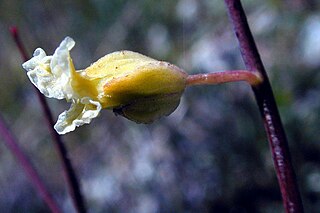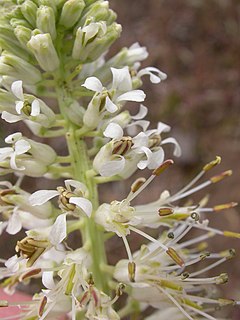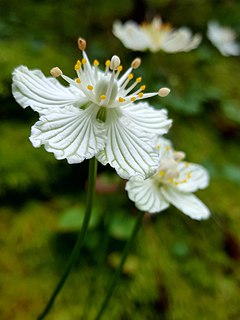
Thelypodium howellii, the Howell's thelypody or Howell's thelypodium, is a rare plant of the Western United States. It is endemic to a relatively small area on the borders of three western States: Oregon, Nevada, and California.

Rorippa austriaca is a species of flowering plant in the family Brassicaceae known by the common names Austrian yellow-cress and Austrian fieldcress. It is native to parts of Europe and Asia, and it is known in North America as an introduced species and sometimes a noxious weed. It can grow in disturbed habitat, such as roadsides, and in very wet habitat such as mudflats. It is a perennial herb growing upright to erect, reaching a maximum height near one meter. The branching stem bears hairless blue-green lance-shaped leaves up to 10 centimeters long. The bases of the upper leaves clasp the stem. The inflorescence is a raceme at the top of the stem and the ends of stem branches. The mustardlike flowers have small yellow petals. The fruit is a plump silique a few millimeters long, but many plants do not fruit and seed production is rare. Reproduction in this species is more often vegetative, the plants concentrating their growth in belowground tissue and spreading clonally. The root system of the plant is particularly aggressive, sending up many new plants as it spreads.
Packera pseudaurea is a species of flowering plant in the aster family known by the common name falsegold groundsel. It is native to North America, where it can be found in western and central parts of Canada and the United States. It grows in mountain habitat such as meadows, streambanks, and woodlands.

Silene bernardina is a species of flowering plant in the family Caryophyllaceae known by the common name Palmer's catchfly.

Streptanthus glandulosus is a species of flowering plant in the mustard family known by the common name bristly jewelflower. It is native to California and southwestern Oregon, where it grows in many types of habitat, including grassland, chaparral, and woodlands. Genetic and other analyses indicate that it is a species complex with ten subspecies which evolved as populations were isolated from each other. The complex includes subspecies previously considered separate species, such as the rare Tiburon jewelflower endemic to the San Francisco Bay Area. Plants in the complex are variable. In general they are annual herbs growing 10 centimeters to over a meter in height. They may be hairless to hairy to bristly. The ephemeral basal leaves have blades borne on winged petioles. Leaves higher on the stem are linear to lance-shaped and clasp the stem at their bases. Flowers occur at intervals along the upper stem. Each flower has an urn-shaped calyx of sepals one half to over one centimeter long which can be most any color from white to yellowish to pink or purple to nearly black. Purple, white, or purple-veined white petals emerge from the tip. The fruit is a straight or curving silique up to 11 centimeters long.
Streptanthus gracilis is an uncommon species of flowering plant in the mustard family known by the common name alpine jewelflower.
Streptanthus oliganthus is an uncommon species of flowering plant in the mustard family known by the common name Masonic Mountain jewelflower. It is native to western Nevada and eastern California, where it grows in the rocky hills east of the central Sierra Nevada. Its habitat includes forest, woodland, sagebrush, and mountain talus. It is a rhizomatous perennial herb producing a hairless, waxy, usually unbranched stem up to about 40 or 50 centimeters in maximum height. The basal leaves have lance-shaped, smooth-edged blades up to 10 centimeters long borne on fuzzy to rough-haired petioles. Leaves higher on the stem have shorter blades which may clasp the stem at their bases. Flowers occur at intervals along the upper stem. Each has a bell-shaped calyx of purple sepals no more than a centimeter long. The petals emerging from the tip are reddish purple or purple-tipped. The fruit is a smooth, flat, straight or slightly curved silique up to 8 to 10 centimeters long.

Streptanthus tortuosus is a biennial or short lived perennial plant in the mustard family (Brassicaceae) known by the common names shieldplant, shieldleaf, and mountain jewelflower.
Thelypodium brachycarpum is a species of flowering plant in the mustard family known by the common names shortpod thelypody and short-podded thelypodium. It is native to parts of northern California and southern Oregon, where it grows in several types of habitat, including alkaline wetlands and serpentine soils.
Thelypodium crispum is a species of flowering plant in the mustard family known by the common name crisped thelypody.

Thelypodium integrifolium is a species of flowering plant in the mustard family known by the common names entireleaved thelypody and foxtail thelypodium. It is native to much of the western United States, including the Great Basin and surrounding plateaus and deserts.

Thelypodium laciniatum is a species of flowering plant in the mustard family known by the common name cutleaf thelypody. It is native to western North America, particularly the Great Basin and surrounding plateau and foothill habitat, where it grows on dry rocky cliffs and hillsides in sagebrush and scrub, usually below 2,400 metres (8,000 ft) elevation.

Thelypodium milleflorum is a species of flowering plant in the mustard family known by the common names manyflower thelypody and many-flowered thelypodium. It is native to western North America, particularly the Great Basin and surrounding plateau, desert, and foothill habitat, where it grows in sagebrush and scrub.

Thelypodium stenopetalum is a rare species of flowering plant in the mustard family known by the common names slenderpetal thelypody, slender-petaled thelypodium and slender-petaled mustard. It is endemic to the San Bernardino Mountains of southern California, where it is known from only three or four extant occurrences in moist mountain meadows near Big Bear Lake. Its remaining habitat is considered seriously threatened and the plant is a federally listed endangered species in the United States.

Paysonia stonensis is a species of flowering plant in the family Brassicaceae, known by the common name Stones River bladderpod. It is endemic to Tennessee in the United States, where it is limited to Rutherford County. It grows only in the floodplains of the Stones River, and certain tributaries.

Parnassia caroliniana is a species of flowering plant in the Celastraceae known by the common name Carolina grass of Parnassus. It is native to the southeastern United States, where it occurs in North Carolina and South Carolina, with an isolated population in the Florida Panhandle.
Thelypodium eucosmum is a species of flowering plant in the mustard family known by the common names arrow-leaf thelypody and world thelypody. It is endemic to Oregon in the United States, where it is known from Grant and Wheeler Counties. There are also historical records of the plant from Baker County.
Aristida rhizomophora is a species of grass known by the common name Florida threeawn. It is endemic to Florida in the United States.

Penstemon acuminatus is a species of flowering plant in the plantain family known by the common names sharpleaf penstemon and sand-dune penstemon. It is native to the northwestern United States, where it occurs in Washington, Oregon, Idaho, Utah, and Nevada.

Penstemon cyaneus is a species of flowering plant in the plantain family known by the common names blue penstemon and dark-blue beardtongue. It is native to the western United States, where it is widespread in Idaho, Montana, and Wyoming.












